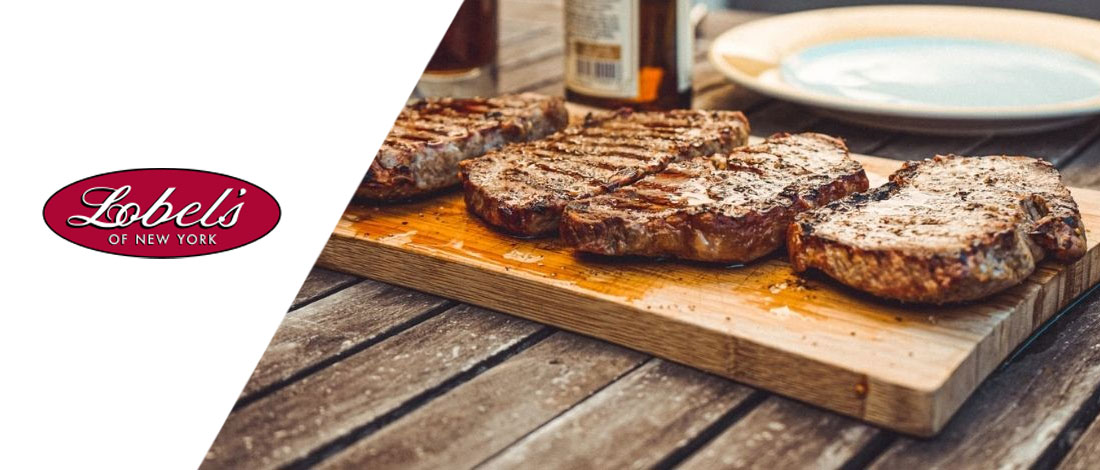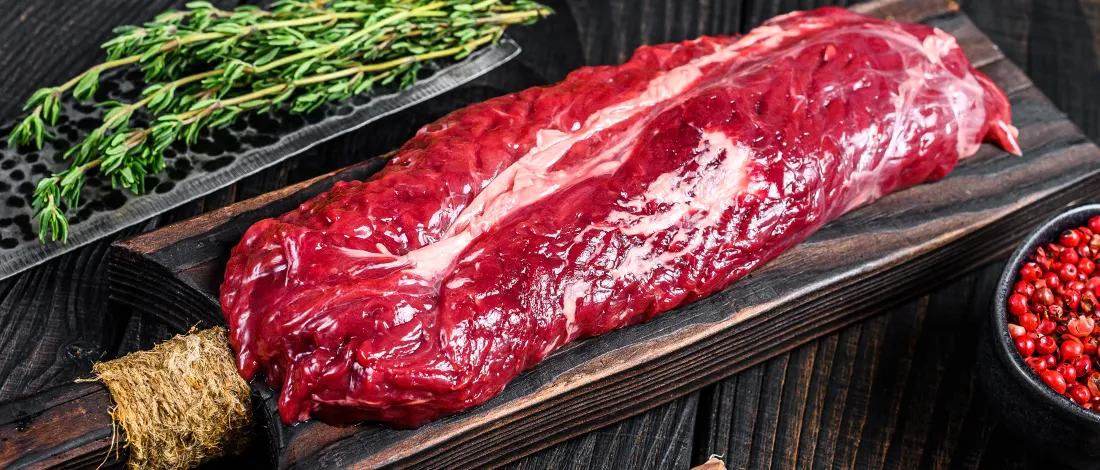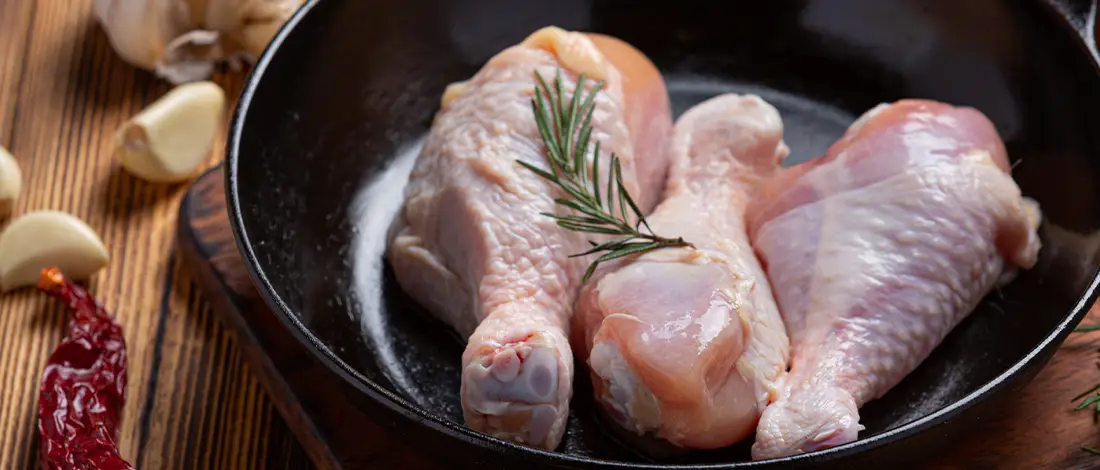Steak represents the pinnacle of meat, and I’ve savored a range of mouthwatering cuts over the years.
For fellow steak aficionados, the top-blade steak is a noteworthy choice.
Although it has long been overlooked due to its tough gristle, this cut is exceptionally tender and juicy. Today, its robust, beefy flavor is winning well-deserved recognition in kitchens.
In this article, we’ll cover key details about the top-blade steak and discuss the best cooking techniques to fully appreciate this delectable cut.
Quick Summary
- Top Blade Steak is a flavorful and palatable cut of beef from the shoulder part of the cow, known for its rich beefy taste.
- It's versatile, suitable for stand-alone dishes, slow-cooked meals, slow-smoked dishes, grill-ready steaks, and stir-fries.
- A 2005 study in the National Library of Medicine investigated the flavor profile of top-blade steaks, finding that these steaks generally had a less intense beef flavor identity and more intense bloody/serumy flavor compared to top-sirloin and tenderloin steaks [1].
- Despite its tenderness, it has a line of gristle running through it, making it more suitable for braising than grilling.
What is Top Blade Steak?
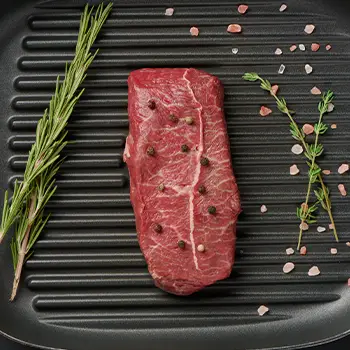
Top blade steak is a cut of beef from the chuck primal (shoulder) section of the cow, richly flavored and palatable [2].
It is taken directly across the top blade muscle, leaving the gristle in.
Thus, the cross-sections have a connective tissue running through the center of the meat, which makes it more appropriate for braising than grilling.
Precisely, this steak is cut from the top blade subprimal, known as the infraspinatus muscle. It is the second most tender muscle, and you shouldn’t overcook it.
“I think over-seasoning is something I tend to do. If it’s a good steak, salt, pepper, and butter are the three key ingredients. But just try not to overcook it, and you’ll be happy.”
- Ree Drummond, American Food Writer
When prepared properly, it is quite tasty. Eat around the line of gristle, and you will be uncovering the little secrets of this underappreciated steak.
Besides, it is pretty affordable; you get excellent value for money.
We also get the flat iron steak from the chuck primal section, the only difference being that it is sliced lengthwise instead of crosswise, removing the rigid strip and forming rectangular-shaped well-marbled beef meat.
You May Also Like: Beef Shoulder Steak Recipe & How To Cook
Other Names for Top Blade Steak

The name top blade is obviously due to where the meat comes from. But it is also known by other names.
- Boneless top chuck steak
Since it has no bone and comes from the top of the chuck primal, it is simply known as boneless top chuck steak.
- Chicken steak
If you have been to New York, you have seen the label chicken steak in most supermarkets. Likewise, this name is common in the Northeastern regions of America.
- Book steak
This beef steak also goes by this name due to the line of gristle running through the steak; it resembles a book seam.
5 Blade Steak Uses

This tender piece of meat is a versatile option, from a whole steak and slow-smoked to stir fry.
1. Stand-Alone
Blade chuck steaks are perfect on their own. You can enjoy the gristle without chewing on it. Think braised steak and onions.
2. Slow-Cooked Dishes
The top blade is best used in slow, moist cooking dishes such as casseroles and stews. Due to the tough strip, this cut should be slow-cooked to give a succulent result.
3. Slow-Smoked
The biggest trick for this delicious meat is slow-cooking. And when it comes to smoking, you need to treat it like slow-cooked barbecue. It brings out a tasty smoke flavor. The smoke does the trick, and you don’t need to get fancy with seasonings.
4. Grill-Ready Steaks
Often overlooked due to its unappealing fatty appearance, this steak brings out a heavenly tenderness and incredible taste when marinated before grilling.
It can be used as a grill-ready steak for your barbecue nights. It takes on the flavor of the ingredients used in the marination.
5. Stir-Fry
Although tasty enough to be enjoyed on its own, this blade steak is best when used in stir-fry dishes.
What is the Taste and Texture of the Blade Steak?
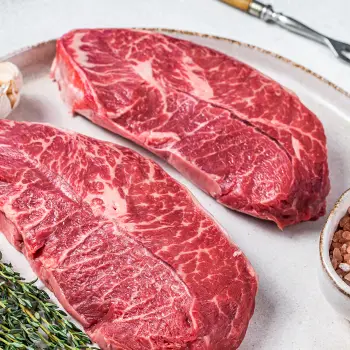
Cuts from the shoulder region have a rich, creamy, beefy flavor due to the significant amount of marbling. It tastes more like chuck steaks or flat iron steaks.
The meat around the gristle is very tender, but it can get chewy if you overcook it or take the gristle.
Therefore, it would be best if you cooked it over medium heat to maintain its tenderness.
What’s more, it is thicker, uniform in size, and meatier, making it a better option than the flat iron steak when it comes to preparation.
You get more control over this hidden gem in the kitchen.
Top Blade Nutrition Profile
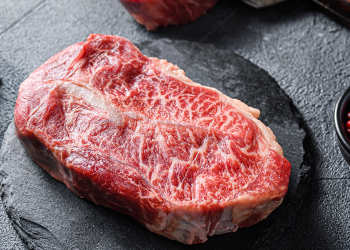
According to the US Department of Agriculture, top blade beef is low in calories compared to other cuts, with about 2.9 grams of saturated fat and 160 calories in a 3-ounce serving [3]. As you can see, it is low in saturated fat.
Besides, it provides 8.2g of zinc, 2.6mg of iron, and 28g of protein, which offers 48% of the daily recommended protein intake.
Each top blade cut is roughly 8 to 10 oz. which is plenty for one person, but the portion size also depends on your appetite.
Top Blade Steak Cooking Methods
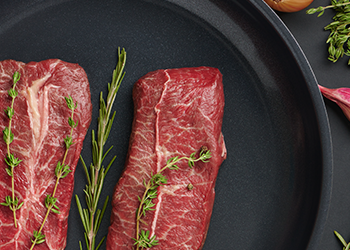
The best way to cook this blade steak is to braise or stew it. Since it comes with a chewy strip, it is best prepared in slow, moist cooking.
Despite coming from the chuck, it is actually among the top soft cuts just below the soft tenderloin.
But why is it not a favorite of chefs and home cooks?
The cartilage is its main flaw. However, there are excellent recipes to cook this beef.
You can remove the cartilage, slice it into chunks and use on skewers or stir-fries, or cook it whole in brown gravy for a few hours.
And what about grilling? Not the best method; you run the risk of overcooking it and turning the gristle into a chewy, thick rubber band. Trust me, you don’t want to ruin your steak.
How Do You Tenderize a Blade Steak?

The secret to a soft texture is to cook it low and slow, which breaks down collagen, leaving you with soft meat.
And, don’t forget the power of brine; ensure to salt your cut, whether marinating or not. Salt helps to break down the proteins for a smooth texture.
But slow cooking is not the only way; you can grill it too.
Preparing Blade Steak for Grilling or Smoking
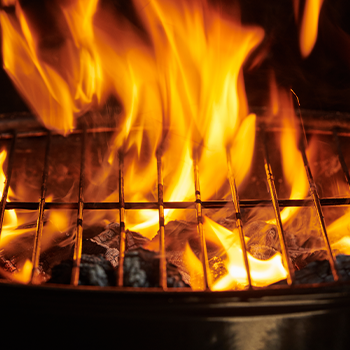
As I mentioned earlier, the blade stake adheres to the no-grill rule. But if you have to, don’t fret!
Before you grill the meat, remove the tough sinew. Next, divide the meat horizontally and remove the connective tissue with a sharp knife, leaving you with two halves (this is the same way a flat iron cut is made).
Season the halves with salt and black pepper on both sides. Marinating the beef infuses more juicy flavors.
The trick to a perfect blade steak grill is to remove the cartilage, use medium heat, and double heat the steak.
Thin Sliced Top Blade Steak Recipes

Blade steaks are best prepared in a slow cooker; they stay flavorful and soft after you slow cook them for a long time.
Considering they lack a fat cap, they require a lot of moisture to cook.
They are mainly seasoned with salt (preferred seasonings can be used) to infuse flavor and tenderize, added to a slow cooker - deep skillet or frying pan, and simmered for several hours.
If you go for a frying pan, you need to transfer the steak to a casserole dish and add liquid to cover it, of course, depending on your recipes.
Here are some great blade steak recipes to get you started:
- Braised blade steak with mushrooms and broccoli recipes
The blade steaks are simmered in ginger, hoisin, chili, and garlic, and they will melt in your mouth. You can serve them with broccoli salad, mushrooms, and fluffy rice.
- Grilled marinated blade steaks
Marination recipes are great for this beef as they remove the thick rubber band feeling and add moisture needed because of the lack of fat.
Blade steaks are marinated in soy sauce, olive oil, fresh coriander, green and red onion and then prepared on the barbecue for about 4 to 7 minutes.
Turn them once on each side. You can get creative with side dishes such as herb mashed potatoes that add an earthy flavor to the blade steak.
If you are looking to cook thinly sliced blade steaks, you might consider flat iron recipes as flat iron steaks are thinner compared to blade stakes.
Where to Buy this Steak?

Blade steaks have made their way into the market and are more available in supermarkets and grocery stores. They are economical and easy to find.
I recommend checking with your local butchery for high-quality tender meat with more marbling, as your butcher is your best bet.
Keep in mind that this steak may come with a different name.
Another option is to check out the online meat markets and see if you can find these steaks there.
Related Articles:
References:
- https://pubmed.ncbi.nlm.nih.gov/16230660/
- https://www.certifiedangusbeef.com/cuts/Detail.aspx?ckey=100
- https://fdc.nal.usda.gov/fdc-app.html#/food-details/169476/nutrients

